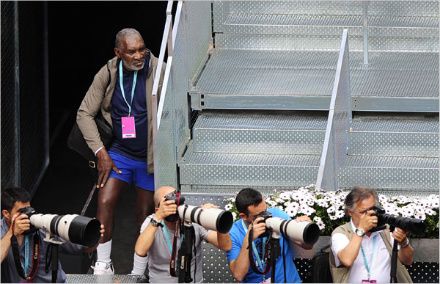I have no idea how I missed William C. Rhoden's New York Times piece on Richard Williams and Oracene Price and their future in tennis.

When Venus Williams broke through more than a decade ago, tennis officials predicted a far-reaching impact: a deluge of young African-American players from places like Compton, Calif., and Harlem would be playing world-class tennis.
More than a decade later, Venus and her sister Serena continue to dominate a sport that is still waiting for young African-American women to make the journey from urban areas to the world stage. Why hasn’t there been another Venus or Serena? The question is asked during every United States Open, and there never seems to be a plausible answer.
“I’ve been actually thinking about that, too, and wondering why and looking for them,” Oracene Price, their mother, said Monday during a telephone interview. “I was hoping that there would be one following them, but it seems like that hope is kind of fading. It’s a disappointment.”
•
Price and her former husband, Richard Williams, have presided over one of the great stories in tennis history: the rise of Venus and Serena Williams. Coached by their father, the sisters first played on public courts in Compton, and have grown to dominate women’s tennis. But why hasn’t their success been duplicated?
Studies have shown that more African-American girls were attracted to the game when the Williamses did well. Few, however, have stuck with the sport — fewer still in places where high unemployment and a lack of resources and exposure put the pursuit of a tennis career out of reach.
“You hear a name and they never come through,” Price said.
Kevin Clayton was hired this year as the United States Tennis Association’s chief diversity officer. His mission was to begin an aggressive initiative to attract a larger pool of players that more closely resembles the United States’ changing demographics.
“Our image as an industry has not really connected to that community,” Clayton said Monday. “It hasn’t been a focused effort where we’ve said, ‘Tennis is for everybody.’ ”
Clayton said that the U.S.T.A., with the best intentions, would show up in places like Harlem and Bedford-Stuyvesant, put a few rackets in kids’ hands and call that diversity.
The U.S.T.A. realized that there must be a deeper investment in the communities, targeting potential athletes and forging business relationships. Clayton is reaching out to historically black colleges and universities; African-American fraternities and sororities; and prominent social and service organizations to spread the word about tennis.
Beyond that, the U.S.T.A. could use the guidance and counsel of two people who broke the mold and created two champions. The organization should formalize its relationship with Oracene Price and Richard Williams. There is not a title broad enough to encompass what they could do, but let’s call them Ministers of Tennis, in charge of giving the sport its long-sought-after traction in underserved areas.
Price and Williams are divorced, but they have the answers to many questions that have puzzled the U.S.T.A. about bringing large numbers of African-American players — especially young girls — to tennis and turning them into champions.
Williams is more of a training guru, a scout who recognizes talent. Price, as she did with her daughters, could prepare talented young women emotionally for the rigors of world-class tennis. Their greatest challenges would have nothing to do with what takes place on the court. The players Price and Williams find and mentor would enter a world that is largely unfamiliar, often uncomfortable, initially intimidating and hostile — often without intending to be.
Price and Williams have helped Venus and Serena negotiate this world and they have done it largely on their own terms.
“It’s a totally different world,” Price said. “And if they don’t know how to cope in it and deal with the things they have to deal with, they won’t make it.
“If they can’t stand on their own as women, not reading all their own press, they can’t make it.” They could do the same for an untapped population of players the U.S.T.A. says it wants to target.
•
U.S.T.A. programs are commendable and tennis academies are often crucial, but if the Williams sisters have demonstrated anything it is that the major battles are fought and won in the mind.
“It’s not just programs,” Price said. “They have to be trained in their heads. It takes a lot of mental ability. They have to be prepared for the ups the downs — everything. If they’re not willing or able to do that and they’re not committed to doing that, then it’s going to be difficult.”
People often talk about the economic realities that make tennis seem unattainable for many. Money can be overstated.
“There’s a way around that,” Price said. “You don’t have to have the academy that’s just a bunch of people hitting balls. Anyone can learn to hit a ball; what’s important is what you have behind the ball, and what kind of mind you have when you hit it.”
Where are the next Venus and Serena?
Their parents could be pretty good judges of where and how to look.
I'll take it a step further. Why can't they work with our Fed Cup team as well? I'm just saying...

1 comment:
Whatever Serena and Venus has they need to bottle it. Both women are amazing fighters...so mentally strong.
Post a Comment